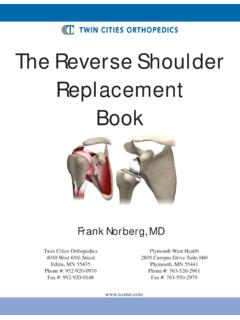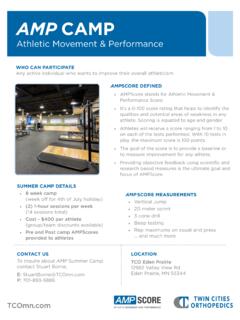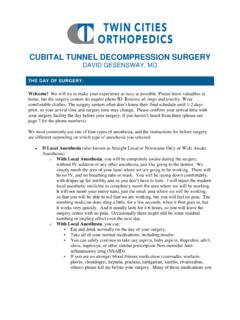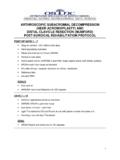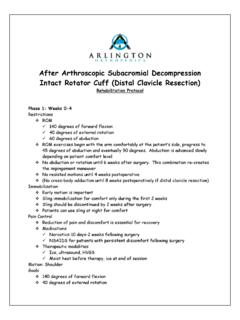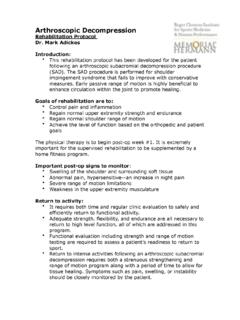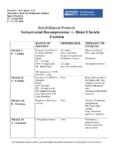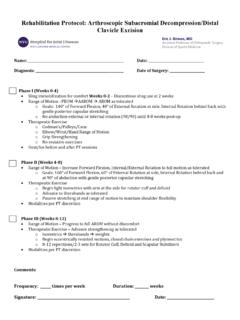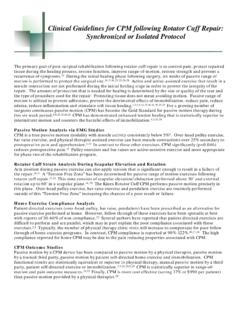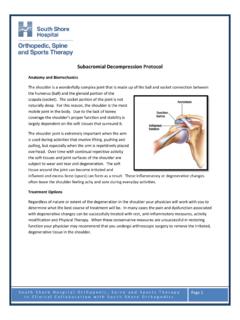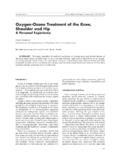Transcription of Corey A. Wulf, MD NON-SURGICAL ROTATOR CUFF …
1 4010 West 65th Street Edina, MN 55435 Phone: 952-944-2519 Fax: 952-944-0460 - 1 - NON-SURGICAL ROTATOR CUFF TEAR rehabilitation PROGRAM PHASE I: Weeks 0-4 Restrictions Avoid provocative maneuvers or exercises that cause discomfort o Includes both offending ROM exercises and strengthening exercises Patients may have an underlying coracoacromial bursitis, therefore ROM exercises and muscle strengthening exercises should begin with the arm in less than 90 of abduction Avoid abduction-rotation recreates impingement maneuver Avoid empty-can exercises Immobilization May have brief sling immobilization for comfort only (3-6 days) Pain Control Reduction of pain and discomfort is essential for recovery Medications o NSAID s with caution in the elderly population o Subacromial/intra-articular injection of corticosteroid and local anesthetic.
2 May be considered at discretion of physician Therapeutic modalities o Ice, ultrasound, HVGS o Moist heat before therapy, ice at end of session Shoulder Motion Goals Internal and external rotation equal to contralateral side, with the arm positioned in less than 90 of abduction Exercises Begin with Codman pendulum exercises to gain early motion Passive ROM exercises o Forward flexion o Extension o Internal and external rotation o Capsular stretching for anterior, posterior, and inferior capsule by using the opposite arm Corey A. Wulf, MD 4010 West 65th Street Edina, MN 55435 Phone: 952-944-2519 Fax: 952-944-0460 - 2 - Avoid assisted motion exercises o Forward flexion o Extension o Internal and external rotation Progress to active ROM exercises o Wall-walking Elbow motion Passive to active motion, progress as tolerated o 0-130 o Pronation to supination as tolerated Muscle Strengthening Grip strengthening (racquetball, etc.)
3 Use of the arm for activities of daily living below shoulder level Criteria for progression to PHASE II Minimal pain and tenderness Improvement of passive ROM Return to functional ROM PHASE II: Weeks 4-8 Goals Improve shoulder complex strength, power and endurance Restrictions Avoid provocative maneuvers or exercises that cause discomfort for the patient Includes both ROM exercises and strengthening exercises Immobilization None Pain Control Reduction of pain and discomfort is essential for recovery Medications o NSAID s with caution in the elderly population o Subacromial/intra-articular injection of corticosteroid and local anesthetic; may be considered at discretion of physician Therapeutic modalities o Ice, ultrasound, HVGS o Moist heat before therapy, ice at end of session Shoulder Motion Equal to contralateral shoulder in all planes of motion 4010 West 65th Street Edina, MN 55435 Phone: 952-944-2519 Fax.
4 952-944-0460 - 3 - Exercises Passive ROM Capsular stretching Active-assisted motion exercises Active ROM exercises Elbow Motion Passive to active motion, progress as tolerated o 0-130 o Pronation and supination as tolerated Muscle Strengthening Three times per week, 10-15 repetitions, for three sets Strengthening of the remaining ROTATOR cuff muscles Begin with closed-chain isometric strengthening o Internal rotation o External rotation o Abduction Progress to open-chain strengthening with very low weight dumbbells or equivalent o Exercises performed with the elbow flexed to 90 o Starting position is with the shoulder in neutral position of 0 forward flexion, abduction, and external rotation o Exercises are done through an arc of 45 in each of the five planes of motion Strengthening of deltoid Strengthening of scapular stabilizers o Closed-chain strengthening exercises Scapular retraction (rhomboids, middle trap) Scapular protraction (serratus anterior) Scapular depression (latissimus dorsi, trapezius, serratus anterior) Shoulder shrugs (upper trap) o Progress to open-chain scapular stabilizer strengthening Criteria for progression to PHASE III Full painless ROM No pain or tenderness with strengthening exercises PHASE III.
5 Weeks 8-12 Goals Improve neuromuscular control and shoulder proprioception Prepare for gradual return to functional activities Establish a home exercise maintenance program that is performed at least three times per week for both stretching and strengthening 4010 West 65th Street Edina, MN 55435 Phone: 952-944-2519 Fax: 952-944-0460 - 4 - Functional Strengthening Plyometric exercises Progressive, Systematic Interval Program for Returning to Sports Throwing athletes Tennis Golf Maximal improvement is expected by 4-6 months Warning signals Loss of motion Lack of strength progression especially abduction and forward elevation. Keep in mind goals may be limited depending upon patient health status, age, and tear size.
6 Continued pain especially at night Treatment of Warning signals These patients may need to move back to earlier routines May require increased utilization of pain control modalities as outlined above May require surgical intervention THIS PROTOCOL PROVIDES YOU WITH GENERAL GUIDELINES FOR THE NON-SURGICAL rehabilitation OF THE PATIENT WITH A FULL-THICKNESS ROTATOR CUFF TEAR. SPECIFIC CHANGES IN THE PROGRAM WILL BE MADE BY THE PHYSICIAN AS APPROPRIATE FOR THE INDIVIDUAL PATIENT. QUESTIONS REGARDING THE PROGRESS OF ANY SPECIFIC PATIENT ARE ENCOURAGED, AND SHOULD BE DIRECTED TO Corey A. WULF, MD @ 952-944-2519 REFERENCE Brotzman, & Wilk, (2003). Clinical orthopaedic rehabilitation (2nd. Ed.). Mosby.


